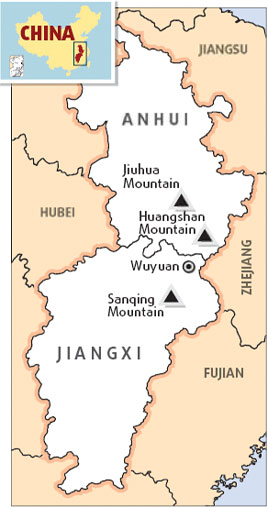|

The heavy snow in southern China has forced many scenic spots to shut down temporarily and travel agencies canceled package tours during the Spring Festival Holiday. But the snow has also created icicles and other spectacular sights rarely seen in the regions. As snow recedes before the advancing spring, locals are getting ready for guests.
Many scenic regions are offering sizeable discounts for entrance tickets, accommodation, food and transportation. Some travel agencies are offering southern tours at half the price of the same routes in January and February.
There are many famous tourist destinations in Jiangxi and its neighbor Anhui province. It is worthwhile to plan a week-long trip to explore the area in March, when spring is in full swing in the region.
Huangshan, or Yellow Mountain, of Anhui in East China is a good place to start the trip with direct flights between Hong Kong, Beijing, Shanghai and other major Chinese cities. Travelers can explore nearby scenic spots during the day and return to hotels in the small and neat city at night easily.
Although pines can be found on most mountains, the needled giants on Huangshan Mountain are widely regarded as the best in China.
The famed Yingkesong (Greeting Guest Pine) is more than 10 m tall and looks like a hospitable host extending an arm to receive guests.
The local tourist administration took special care of the pines this winter, making sure that heavy snow wouldn't cause serious damage.
At the foot of Huangshan Mountain, one can visit ancient villages such as Xidi and Hongcun. The white-washed walls with black tiles and roofs shaped like a bird's wing are typical of the Hui style of architecture. Many grandiose courtyards are still inhabited by descendants of their original founders.
Many buses shuttle along the 120-km highway between Huangshan and Wuyuan of Jiangxi. In March and April, the county attracts hordes of photographers with yellow rape flowers adjacent to the hills.
Xiaoqi Village, which was first built in AD 787 of the Tang Dynasty (AD 618-907), has many preserved buildings. Throughout history, people from the village have won first titles in the imperial examination. After they retired, the former prime ministers all chose to build or expand homes at Xiaoqi.
Jiuhua Mountain, which is also 120 km from Huangshan, is a holy site for Buddhism. Last November, the Chinese government sent a statue of the Ksitigarbha Bodhisattva to South Korea, as a token of the friendship between the two nations.
In the Tang Dynasty, a prince of Silla (Korea) known as Kim Gyo-gak journeyed to Jiuhua Mountain to practice Dharma. He passed away at 99 and his body remained the same three years after his death. Buddhists all believe Kim to be an incarnation of Ksitigarbha Bodhisattva, a prominent disciple of Sakyamuni. Today, the Korean prince rests in a pagoda at the Dizang Temple.
The tourist administration has cleared away snow and ice for visitors. Many pilgrims from South Korea and Japan have gathered at the temples on the mountain.
Not far away is Sanqing Mountain that commands a high place in Taoism. It has been listed by the country as a candidate this year as a World Natural Heritage Site.
Last week, major routes in the mountain were reopened for tourists. Some new sites have been added, featuring frozen waterfalls, fog-shrouded temples and giant trees covered in ice.
At some of the peaks, visitors may catch a glimpse of Buddha's Aura, a ring of light surrounding a human shadow amid the clouds. Local people believe seeing this natural wonder will bring good fortune in the coming year.
(China Daily 02/28/2008 page19)
|